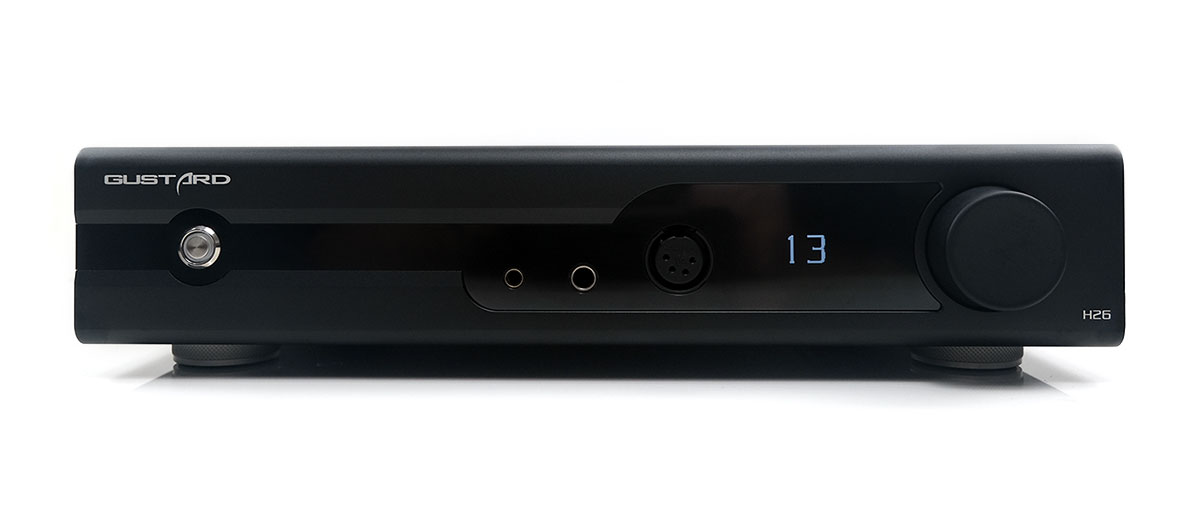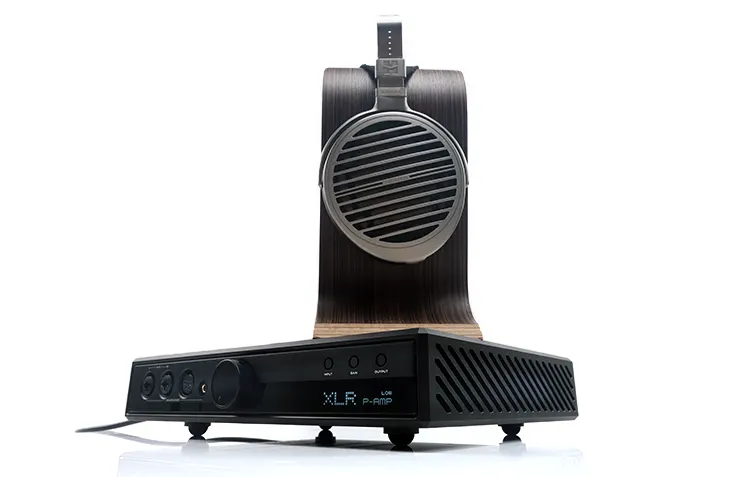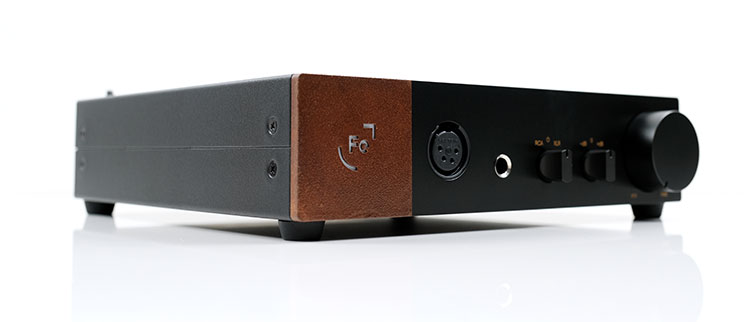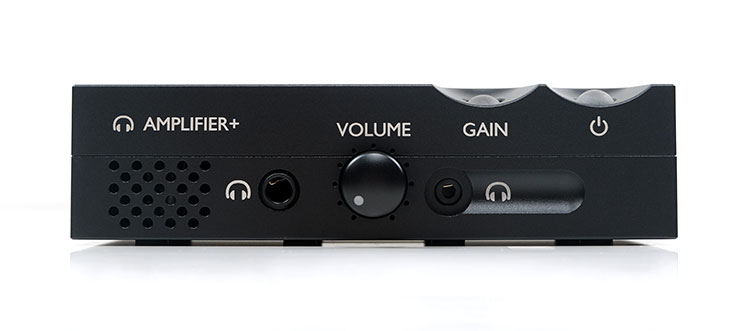Selected Comparisons
The following comparisons to the Gustard H26 were completed using a mix of the Topping DX9 (DAC), the Cayin N8ii via I²S, and the Cayin Mini-CD MK2 for sources.
I also used the Austrian Audio Composer, the Focal Utopia 2022, and the ZMF Headphones Caldera Closed for headphone pairings.
HIFIMAN Prelude
The HIFIMAN Prelude was launched last year with our review in Q4 2023 but its origins began with their partner brand Goldenwave as a DAC/amp. This desktop amplifier was also our Top Gear Award Best Desktop Solid-State Amplifier winner for 2023.
Technical
Like the H26, the Prelude is a fully balanced analog headphone amplifier with an independent balanced pre-amplification circuit.
The Prelude headphone and pre-amp circuits are discrete-designed Class A MOSFET with a single-ended balanced conversion for SE inputs to be converted to a balanced signal output. The H26 does differ slightly on the pre-out with its directly inserted swappable opamps.
The Prelude comes very close to the high-level performance number of the H26. It can churn out 10W into a 32Ω load in balanced mode dropping down to 1W into 300Ω and 560mW at 600Ω.
The H26 does have an edge on paper at 12W into the same 32Ω load and 7.35W compared to 6W at that 64Ω milestone where Susvara owner’s ears start to pick up. The 300Ω numbers from the H26 are more impressive on paper at just over 1.5W compared to 1W from the Prelude.
The Prelude’s pre-amplification balanced XLR output is also industry competitive at 4Vrms per channel on its balanced output with the H26 registering 4-6Vrms with a maximum of 12Vrms for its preamp.
Both amplifiers have a sub-ohm output rating for PO making them both headphones and IEM friendly.
Design
The Prelude has the smaller form factor though the weight difference between them is minimal at around 6kg each. The Prelude is not as tall and with far less depth making it more rack and desktop-friendly.
Not that the H26 is Bartok Apx level of girth but rather it dominates the same space a lot more than the Prelude. Put it this way, the Prelude was stacked on top of the H26 with some ease during this comparison.
Both have what I would say is a similar boxy finish in black but aesthetics-wise I do give a slight edge to the chamfered low-profile Prelude.
The LED screen is a little more engaging with a more attractive matrix display and more status/mode information. When left alone the H26 only shows you the volume so you do have to press into the menu system to see what input and output option you are on.
Of course, the additional space means the I/O on the rear panel of the H26 is more comprehensive.
I do get a feeling Gustard put a lot more effort into pitching this as a system pre-amp with XLR and RCA inputs for several devices as opposed to just 1-2 for the Prelude. Both have a single set of balanced and SE pre-outs for connecting to power amps.
One small difference in the PO lineup is the Prelude’s dual-purpose sockets that accept either a 6.35mm SE or a balanced 3-pin XLR plug. The H26 keeps it more familiar with XLR< 4.4mm and a single 6.35mm.
Performance
The Prelude has more of a ‘gusto’ vibe to its tuning with the Composer, delivering a juicer low-end, and dynamic but intimate vocal imaging. It sounds beefier note-wise but the harmonic balance is slightly rawer on the upper order with a little more noted treble overtone on the mid to upper mids notes using the Composer.
The H26 tones down the fireworks somewhat presenting a warmish tone with a more neutral image, particularly through the mids and highs.
I would call it more refined but it lacks the same dynamic punch and aggression of the Prelude which for some users might be ideal for monitoring or creating a more serene listening experience.
Vocal and cymbal harmonics are slightly smoother from the H26 offering more separation but as mentioned, it’s delivered in a neutral imaging manner.
You get more slam and physicality and perhaps more of an emotional statement from the Prelude’s mids when vocals are in full force with the nuance and delicacy from the H26.
However, take the vocal out, say an instrumental or dance music and I find the mids have a bit more substance from the H26 when paired with the Composer.
The lower-mids presentation has more presence, perhaps due to the more neutral bass weight from the H26 allowing for more presence. Switching to the Prelude, I hear a slightly darker midrange instrumental sound, with more sub-bass and upper-mids emphasis using the same headphones.
Overall, I would pick the H26 for monitoring, detail lovers, and those looking for a more expansive imaging experience with a refined and smooth tonal quality.
I would recommend the Prelude if you are after more physicality and sub-bass weight or want something more immediate and closer for female vocal performances.
Ferrum OOR
The Ferrum OOR is one of the more high-profile recent releases. This desktop analog amplifier was released alongside the HYPSOS in 2021 and won our Top Gear Best Desktop Solid-State Amplifier award the same year.
Technical
As with the H26, the OOR headphone amplifier uses a fully balanced analog circuit design. It can also operate as a balanced preamplifier with volume and output control as well as offering bypass capability to act as a standalone headphone amplifier power stage.
Although both amps are discrete-engineered and transistor-based, the OOR does not use a Class A topology similar to the H26. Instead, the topology is a modified Class AB design though as far as I am aware there are no directly inserted opamps inside the OOR for the pre-out similar to the H26.
There are some differences in the volume control. The H26 uses a matrix volume relay potentiometer whereas the OOR uses an Alps RK27 “Blue Velvet”.
One is a step-based attenuator with nicely balanced incremental steps, as in not too big a jump in volume with good granular control and a nice linear attenuation. The other has excellent wiper contact, a long useable life span, fairly tight channel matching, and excellent granular level control.
Both of these amps are power players for numbers. On a high level, the OOR is very close to the H26 at 8W into 60Ω compared to 7.35W 64Ω. At 64Ω the OOR can do around 7.5W so the difference is minimal, even down to the 1.576W rating at 300Ω compared to 1.6W from the OOR.
One final but massive difference is the Weipu DC coupler on the rear of the OOR for the dedicated HYPSOS PSU. It gives everything a huge lift in terms of dynamics from the OOR. The HYPSOS should be compatible with the H26 if Ferrum updates the system at some point so, the benefits are not exclusive to the OOR.
Design
The OOR looks tiny beside the H26. It is also a fair bit lighter at just under 2 kg. It’s a real beside your laptop or office desktop type of addition to your system whereas the H26 will dominate a rack and almost needs a dedicated shelf.
There are benefits to size though with the H26 offering double the number of balanced and SE analog inputs on its rear panel compared to the OOR though both have a single set of preamp balanced and SE outputs.
The OOR does lack a digital interface on the front panel and only offers two outputs, an XLR and 6.35mm meaning it’s missing the H26’s 4.4mm PO option.
The lack of an LCD panel and remote control from the Ferrum unit is compensated for by an easy access 3-stage gain switch which seems more transformative than the dual gain stage’s dB difference from the H26 version.
Once you connect the OOR to the HYPSOS you get a lot more granular control on some of the PSU settings via an LCD panel and mode dial selector. It does bring in a new dimension but bear in mind the overall cost of both Ferrum units combined is almost 3 times the price of the H26.
Performance
I switched to the Focal Utopia 2022 for this comparison with both amplifiers able to drive it without any issues. It’s a smoother more relaxed tuning compared to the Original Utopia but still with a comparatively narrow smaller soundstage compared to some other flagship open-back headphones.
With the OOR, it’s a drier more neutral tone. I would describe it as a “matter of fact’ presentation with everything cleanly presented in front of you, excellent dynamic range, nothing too warm or soft or shrill and lean.
The H26 does sound like it’s going in a different direction with the Utopia 2022 pairing producing a smoother and warmer instrumental and vocal timbre.
I would say it’s almost euphonic in part depending on the DAC you have connected to it. For both, I paired them with the Topping DX9 DAC output with the H26 sounding the ‘sweeter’ of the two for vocals but with a softer attack and note definition on the low-end notes.
The higher level of contrast from the OOR does gel very well with the Utopia 2022’s warmish tonal character. Bass notes have more punch, less decay, and feel pacier. The H26 delivers a less impressive punch and dynamic with the Utopia but extends a bit deeper.
And that final statement alludes to where the H26 has a clear edge, its staging expanse. It creates an airier more atmospheric soundstage pitching deeper, taller, and with more noticeable channel separation.
The OOR images fantastically well due to the better tonal accuracy but it’s a centered soundstage giving it more of a well-padded recording studio-type quality to recordings.
Chord Electronics Anni
The Chord Electronics Anni was launched in 2022 with our review coming shortly after. It has a similar price point to the Gustard H26 and is marketed to headphones and speaker users.
Technical
The Anni is an integrated Class AB headphone and speaker amplifier, designed as part of the Qutest series of desktop components. Unlike the H26, it is a single-ended topology with no balanced inputs or outputs.
Also, unlike the H26, it does not have a preamp functionality to feed power amps in a HiFi system but rather a direct connection to speakers as a power amplifier in its own right.
Granted, a MOFSET-based amplification peak of 10W into an 8Ω load might not be the stuff of legends but for moderate 2.1 setups, this will save you on additional power amp units.
On the PO side, its single-ended capability is very competitive at 3W into a 32Ω load, dropping down to 500mW for a 300Ω load. If we compare like for like that is higher than the H26’s SE performance on the same load at approximately 2.3-2.4W.
Of course, the H26 is balanced and can churn out up to 6W undistorted into 32Ω or 12W pushing it to the max on the same load with a 1.5W rating for 300Ω so, there is more power on tap here if you need it.
Both amplifiers have two-stage gain controls with the Anni dB difference around 8-9dB between high and low. Sadly, no data on the H26 dB difference but it might be a shade lower based on subjective listening.
Design
Goodness, tiny versus huge here. The Anni can be held single-handed and weighs just 625g which is nearly 200g less than the weight of the supposedly portable iBasso DX300 MAX DAP.
If there is one amplifier that can comfortably fit the bill as transportable and desktop-sized then the Anni is, and the H26 is quite frankly the complete opposite.
You can stack the Anni with the Qutest and the Huei and still stick it in a tiny corner of the table using a DC input system to link up all three into one power system. It does have a nice level of flexibility.
The Anni is just as robust as the H26 for build materials, if not more so considering it was designed using a two-piece shell CNC machined from a single aluminum billet.
The only problem is that it is so tiny you cannot stack anything on it. The Anni will of course stack quite comfortably on the H26, well, somewhere in the corner of the H26 top panel.
Of course, you have to put up with Chord’s color orb system for controls, the lack of balanced PO and LO, and a DC15V power supply rather than an easily replaceable 3-prong cable from the H26.
I prefer the much more intuitive LCD panel of the H26 with its multifunctional dial and remote control. This setup feels more accessible and memorable to the everyday user.
One aspect of the Anni I do feel is behind the H26 is the dual-function traditional potentiometer knob. It feels a little cheap and is not quite as granular or as tight on the volume control compared to the matrix relay attenuator design on the Gustard unit.
Performance
Moving from the Anni to the H26 is like opening the door from a small room and walking into the great outdoors. At least when paired with my final choice of headphones, the ZMF Headphones Caldera Closed.
That might sound harsh on the Anni as I quite like its bombastic presentation, and it is more exuberant on the lows compared to the firm but more tranquil bass performance of the H26. If there is a choice for bassy music the Anni is the clear winner here.
Rather the descriptor relates to the sheer openness of the H26’s soundstage, the depth and holographic nature of which far outstrips the Annis’ rather vague imaging and center-focused positioning.
Thus, the Anni presents a firmer but narrower more intimate soundstage with an increasing perception of vagueness the further you traverse from that solid center point. Vocals sound full-bodied or robust but not quite as sweet and texture-driven as the H26’s treatment of the same recordings.
The Anni is great for bass and vocal dynamics, perhaps the better of the two but it has a more one-dimensional character whereas the separation and layering of the H26 offer a more immersive and dare I say it, a more interesting listening experience from the Caldera Closed.
For any Closed-back headphone pairing, and save for bass weight, the H26 does a much better job creating the oft-craved-for ‘open-sounding’ experience.
My Verdict
The Gustard H26 surprised me in a very nice kind of way. This solidly built headphone amplifier offers a pleasingly smooth and refined tonal quality with a strong focus on spatial detail, all delivered within a very spacious presentation.
It is hard to believe that this type of performance and feature excellence can be found at this price point in 2024. Everything just keeps getting more and more expensive these days.
Sure, we have cheaper highly neutral headphone amplifiers from the likes of Topping and SMSL for maybe half or even less but none of them sound this ‘regal’ if I may call it that. None of them gel so wonderfully well with such a wide range of headphones.
Some might quibble at the slightly neutral low-end quantity and some might be concerned by the non-linear volume control which, combined with a weaker DAC input might give cause for concern regarding the amp’s potential power. I get that; however, the power is there with the right setup.
If the likes of Ferrum and HIFIMAN’s latest high-end amps are beyond your budget, then the H26 is a fantastic analog headphone amplifier with plenty of grunt and system potential for far fewer greens.
Gustard H26 Technical Specifications
Input
- RCA x1: input sensitivity typical: 2-3Vrms; input impedance 4KΩ
- XLR x2: input sensitivity typical: 4-6Vrms max 12Vrms;
- Input impedance 8KΩ
Preamp output
- RCA: 100Ω output impedance
- XLR: 100Ω output impedance
- Frequency response: 20-80kHz/-0.1dB
- SNR>123dB
- Crosstalk<-123dB @ 1kHz
- THD+N: <0.0002%
- IMD: <0.0003%
Headphone amplifier
- Single-ended output (6.35mm) impedance: 0.05Ω
- Balanced output (XLR 4PIN or 4.4) impedance: 0.1Ω
- Frequency response: 20-80kHz/-0.1dB
- SNR 20-80kHz/-0.1dB
- Crosstalk<-120dB @ 1kHz
- THD+N: <0.0005% @ 9700mW into 32Ω LOAD
- IMD: <0.0005% @ 9700mW into 32Ω LOAD
- Maximum undistorted power output: 6000mW into 32Ω Load
- Maximum power output: 12000mW @ 32Ω (THD=1%)
Load per channel
- 64Ω 7350mW
- 150Ω 3125mW
- 300Ω 1576mW
- 600Ω 788mW
Others
- AC power input 100V – 240V (manually adjusted)
- Overall power consumption <30W
- Size W330mm*D260mm*H65mm (protrusion not included)
- Package size W420mm*D360mm*H175mm
- Weight 7.0KG (with package)





